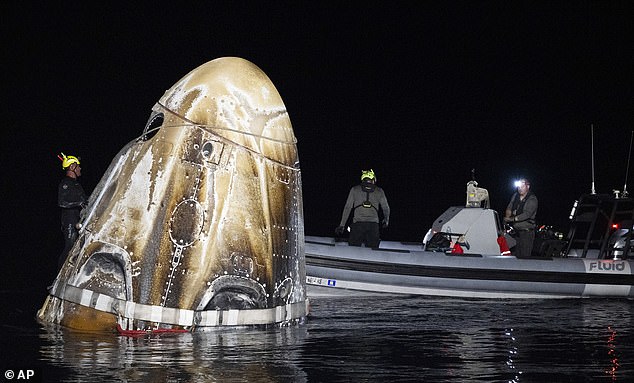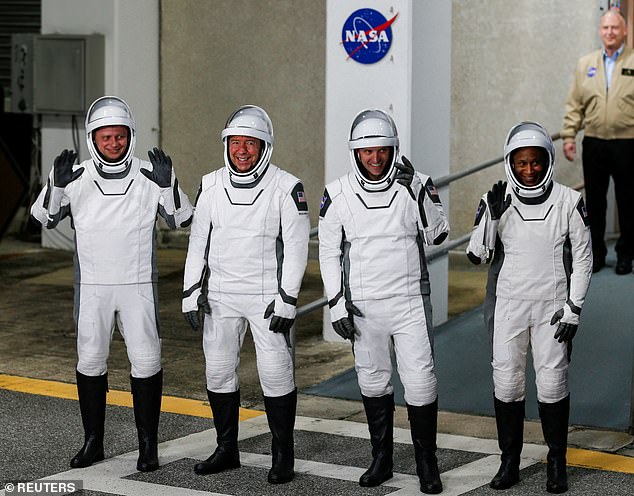A crew of four NASA astronauts were recently hospitalized without explanation after returning to Earth in SpaceX’s Dragon capsule.
After spending more than 200 days on the International Space Station (ISS), the Crew-8 astronauts landed off the coast of Florida in the early morning hours of October 25.
NASA revealed that one astronaut received medical care upon his return, but on Monday it was discovered that all members had been taken to the hospital.
One crew member spent the night but was said to be “in stable condition under observation as a precaution.”
NASA has not released any details about why the crew was hospitalized, which astronaut had to stay overnight, or whether the medical problems were related to their return to Earth.
Following the mysterious incident, a NASA safety panel told SpaceX to focus on crew safety as they prepare for future crewed missions to the ISS.
During an Aerospace Safety Advisory Panel meeting on October 31, former astronaut and committee member Kent Rominger listed a number of “recent issues” with SpaceX’s Falcon 9 rocket and Dragon spacecraft.
He said the setbacks serve as a reminder to remain vigilant as the company increases the pace of its missions.
“Both NASA and SpaceX must focus on the safe operations of Crew Dragon and not take any ‘normal’ operations for granted,” he said.
All four Crew-8 astronauts were hospitalized after their return to Earth, but NASA has not released any details about the reason or reasons why.
The Crew-8 mission launched toward the ISS on March 3, and the crew was initially expected to return to Earth in August.
But a series of delays delayed the return flight in early October, extending what was supposed to be a 180-day stay on the ISS to 235 days.
A typical long-term stay on the ISS lasts six months, or approximately 182 days.
Living on the ISS takes a toll on astronauts’ health, and the longer they stay, the more serious these health problems can become.
After long-duration space missions, astronauts are known to suffer bone and muscle loss, vision problems, kidney stones, cardiovascular problems, and other health conditions.
NASA has not released any information about why the Crew-8 astronauts were hospitalized, so it is unclear if their extended stay on the ISS was the cause.
It is also possible (but not confirmed) that something went wrong during Crew Dragon’s return to Earth.
The incidents Rominger referenced include observations of Crew Dragon’s parachutes during Crew-8’s landing, such as “lag” behavior that caused one of the four main parachutes to open more slowly than the others. SpaceNews reported.
He also cited several problems with SpaceX’s Falcon 9, such as a launch failure in July that grounded the rocket for about two weeks.
In August, Falcon 9 launches were briefly halted after one of the rocket’s boosters was lost during an unmanned ship landing.

The Crew-8 astronauts landed on SpaceX’s Dragon Endeavor on October 25, after a 235-day mission.
And in September, another mishap occurred with the Falcon 9 upper stage engine during a deorbitation operation after the launch of the Crew-9 mission.
As a result, the second state landed outside the target zone and the rocket was grounded for another two weeks, except for one mission.
Even on Sunday, SpaceX canceled the launch of a Starlink satellite scheduled for this weekend due to a helium leak.
“When looking at these recent incidents over the past few weeks, one can say that it is evident that operating securely requires significant attention to detail as hardware ages and the pace of operations increases,” Rominger said.
He added that both NASA and SpaceX will have to “care about the high pace of operations clouding their judgment” to ensure missions are carried out with the appropriate level of attention, time and resources.
Elon Musk’s SpaceX has been a trusted partner of NASA for years and the company has been particularly busy this year.
The leader in commercial spaceflight has already launched more than 100 rockets in 2024, including several crewed missions. Musk has set the ambitious goal of reaching a total of 148 before the end of the year.
This would surpass the 98 launches that SpaceX achieved in 2023.
But the company’s focus on maintaining an accelerated mission schedule, and therefore its leadership position in the commercial space industry, could come at a cost to the health and safety of astronauts.


